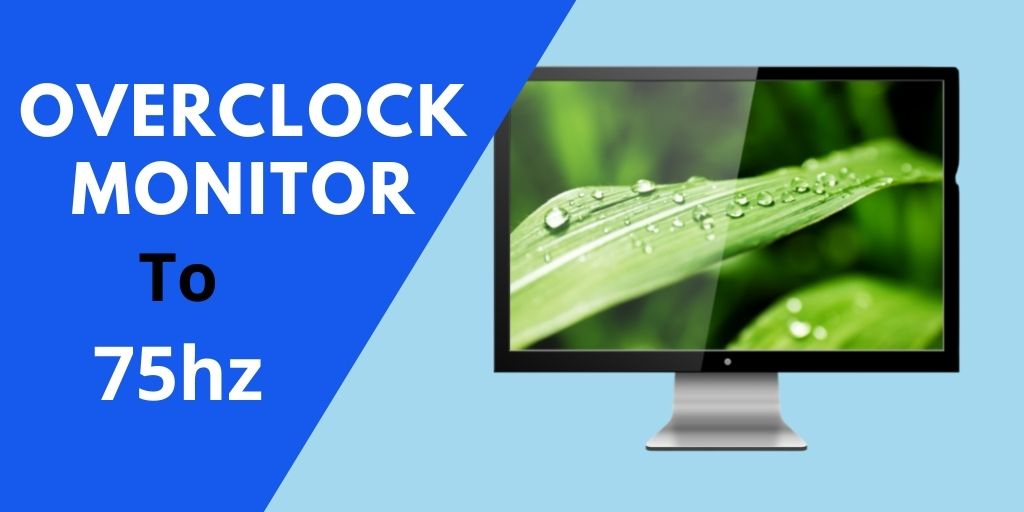When it comes to gaming, you want your experience to be as smooth as possible, so you enjoy the benefits of overclocking your CPU (central processing unit) and GPU (graphics processing unit). But do you know how to overclock your monitor to 75hz? Because a monitor does not have its processing unit, overclocking a display for gaming is not the same as overclocking other components of your computer configuration.
Even though installing an overclocked (OC) monitor takes time and involves a little amount of danger, if done correctly, you may significantly increase your gaming performance while saving a significant amount of money. The monitor’s refresh rate boosting will not necessarily result in an improvement in the performance of your screen. It will need extra monitor overclocking software, and the procedure will differ depending on whether you have an AMD or an NVIDIA graphics card.
This article will tell you how to overclock your monitor to 75hz, some steps to overlock monitors refresh rate, and whether it is safe or not?
Overclocking In A Display Monitor
The phrase “overclocking” denotes the alteration or fluctuation in the refresh rate inventory in the computer display. Overclocking a display is done to get a more significant number of frames per second and improve image quality. Apart from that, you may overclock each perfect recent monitor display; nonetheless, increasing the refresh rate differs from one monitor to the next.
On the other hand, the monitor’s refresh rate is the time it takes for the display panel to update itself once per second. The frame will be refreshed 60 times in one second if you have a display monitor running at 60Hz, 75Hz will refresh the edge 75 times in a second, and so on with increasing refresh rates.
How to overclock your monitor?
Before selecting for the overclocking of the display monitor, you should make sure that you understand the requirements and the main cautions since not all display monitors are compatible with overclocking. When it comes to displaying refresh rates, the 75Hz option is a great option that is safe to use; nevertheless, it is dependent on the display type you are using.
Furthermore, if you employ high-end display panels, it will be easy to achieve the desired speed with a great degree of privilege. If you are looking for information on overclocking your display, let’s move towards the steps.
Steps to Overclocking your Monitor
Overclocking a display typically results in significantly improved performance, but there is a possibility that overclocking will have a detrimental influence on performance. The following steps will guide you through the process:
- The Custom Resolution Utility (CRU) program, created by ToastyX, may be obtained by downloading it.
- This tool enables you to generate custom resolutions and modify your display’s refresh rate for AMD and NVIDIA graphics processors.
- Start by launching the CRU; a window will appear on the right-hand side of the screen with a box titled “detailed resolutions.”
- Select the display that will be overclocked and press “Edit” to proceed.
- The following window that appears will contain a drop-down menu with an option for “Refresh Rate” under the tab labeled “Frequency” on the left-hand side of the screen.
- Increase the refresh rate of your monitor (while within its operating range), and the CRU will automatically adjust the rest of your display settings to reflect the new environment.
- To dismiss the window and return to the main screen, press “OK” twice more times on your keyboard.
- Run the restart.exe file that corresponds to your operating system (OS); if you’re running a 32-bit OS, choose “restart,” and if you’re running a 64-bit OS, choose “restart64.” 6.
- When the display does not reappear after 10 seconds, you may hit F8 to undo any modifications you have made to it.
- Before overclocking your display, you should get acquainted with your operating system’s Safety Mode and recovery options to minimize any possible hazards.
How to overclock monitor to 75hz Nvidia
You may easily overclock your monitor’s refresh rate using the Nvidia Control Panel by following steps.
- Displays your PC’s resolution and graphics card capabilities (which might be out-of-reach on your current monitor).
- Expand the Display section and choose Change resolution from the Nvidia Control Panel.
- Ensure your monitor’s native resolution in our instance 2560×1440, then click Customise.
- It will bring up your Custom Resolutions. You may see random Custom Resolutions produced by default or an empty list.
- Modifying your monitor’s resolution
- Hit Create Custom Resolution opens a new window. You can view your resolution and refresh rate here.
- Keep the Scan Type on Progressive on a progressive screen (1080p, not 1080i).
- Your display usually defaults to 60Hz, up to 10Hz, and test. Adjust the refresh rate after enabling Automatic Timing.
- It should then turn the screen off for a brief second and ask you whether you wish to Apply Changes.
- Don’t panic if you don’t see anything. Wait 15-30 seconds for Windows to discover the mismatched refresh rate. Your monitor may also show a Signal Error.
- You may then adjust the refresh rate in 5Hz increments. Our display can produce 96Hz. For a beautiful cinematic experience, we picked 96hz, which is four times the natural cinema resolution of 24p.
- Choose your desired resolution and refresh rate from the drop-down option under Refresh rate.
- Apply, and your Nvidia graphics card has effectively overclocked your display!
How to overclock monitor to 75hz AMD
You’ll need ToastyX’s Custom Resolution Utility (CRU) To begin overclocking by following steps.
- Launch the application and eliminate all inactive monitors from the drop-down list. It is possible to have many active monitors.
- Then click Add under Detailed Resolutions (maximum of 4 slots) to open a new window.
- Pick Automatic – LCD standard and then change your resolution to your monitor’s native resolution, 1920×1080. Then, at the bottom, you may choose interlaced (only if you have an interlaced monitor, like 1080i, and not a 1080p display) and the refresh rate.
- Add a tiny overclock, like 70hz, then click OK. After that, your new will appear in the Detailed Resolution section. Repeat the method to add two additional frequencies, 75Hz, and 80Hz.
- After this, your top menu will show four Detailed Resolutions. Please restart your computer immediately to take up these new custom resolutions.
- Then right-click on your desktop and choose ddisplay> Advanced display settings > Monitor. Your custom resolutions are now under Screen Refresh Rate. Now it’s only a matter of picking the one closest to your monitor’s refresh rate and applying it.
- Moreover, This should then turn the screen off for a brief second and ask you whether you wish to Apply Changes. Don’t panic if you don’t see anything. Wait 15-30 seconds for Windows to discover the mismatched refresh rate. Your monitor may also show a Signal Error.
- Then keep increasing refresh rates by 5-10Hz until you reach a brick wall. BenQ RL2460H-1 display can deliver 75Hz but not 80Hz.
- After applying the modifications, return to CRU and erase all Detailed Resolutions except the one that works, like 75Hz for our display.
- You’ve now overclocked your AMD graphics card’s display!
Is it safe to overclock 60hz monitor to 75hz?
Overclocking comes with several hazards and limitations that you must consider. How to overclock 60hz monitor? It requires high precision and caution, as previously stated in this article. Anything that pushes the boundaries of human capability is at risk.
- If you increase the frame rate from 60Hz to 120Hz, your CPU and GPU must be able to keep up. Consequently, the overclock (OC) monitor will function quicker and more efficiently, and the heating of its internal machinery will be very evident as a result.
- Furthermore, some manufacturers include a safe overclocking limit to avoid any harm of any type from occurring.
- A slow refresh rate leads to laziness. If your monitor has a sluggish refresh rate, you may utilize the monitor overclocking tool, but bear in mind the disadvantages. That will keep you in the loop.
Conclusion
We have often heard how to overclock monitor to 75hz? However, there are some differences in the procedures and approaches for monitors. Furthermore, before overclocking the monitor, you should ensure that the display panel can increase performance.
Again, this will easily protect you from the intentional harm your system should do. Overclocking the display might destroy the controller chip due to overheating, which causes rapid wear and the thing you won’t enjoy is the increased electrical use. So care is better than cure!


